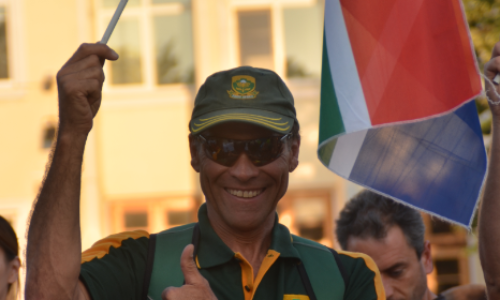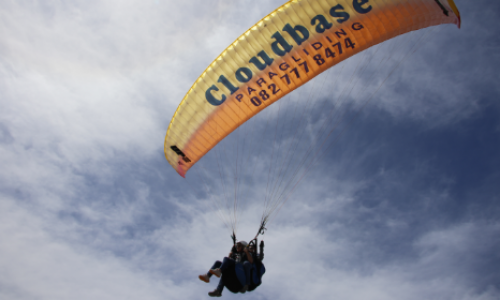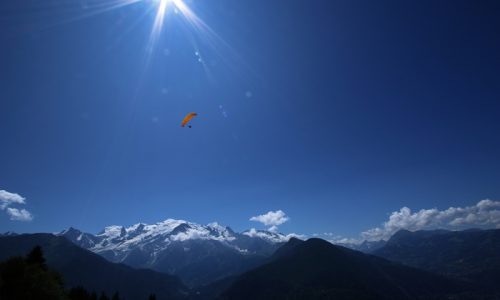Jan Minnaar, is the Chief flying Instructor, and proprietor of Cloudbase Paragliding School, and has been paragliding since April 1991.
He learnt to fly in Cape Town with Daedalus Paragliding under the instructorship of Kobus Botha and Springbok Parachutist and multiple National Paragliding Champion, Jay van Deventer.
In April 1992 Jan, Julian Herbstein and Anthony Allen started as assistant instructors with Jay and Jan took over the day to day running of Daedalus Paragliding. In February 1993 he received his instructor rating. During this time Daedalus saw good growth and organized many popular flyaway weekends to Wilderness.
In July 1993 Jan went as the team manager for the South African National team at the Paragliding World Championships in Verbier, Switzerland. Following on from Verbier. Jan spent a further 2 months in Germany and Switzerland flying and seeing how European schools operated. He also attended a safety course and experienced tow launching from a static winch.
On his return he was offered the position of factory manager at Fun 2 Fly Paragliders in Durban. Together with Herbert Forsthofer, the factory expanded and moved premises.
Jan loved teaching, and so CLOUDBASE PARAGLIDING School was established on the 1st November 1993. As Jan was still working in the Fun 2 Fly factory, teaching was a weekend passion only and this saw the foothills of Eshowe bedecked with paragliders. His commitment to his Cape Town students saw him commuting every 3 months to Wilderness as well. After woking for 18 months for Fun 2 Fly it was growing rapidly ,new partners were brought in and Jan therefore made a decision to leave Fun2Fly and to base himself in Wilderness, where the training conditions were consistently safe, and run his school full time.
Jan set up premises in the Garden Route Town of Wilderness in 1995, including an informal Bed & Breakfast. The camaraderie became legendary. The combination of personal attention, learning experience and fun times when not flyable, ensured steady growth of the school.
In August 1995 the first Alpine Tour was organized, visiting the Austrian Alps and Switzerland. This has become an annual event and has resulted in increased reciprocal visits by foreign pilots. To facilitate this Jan started a new division, CLOUDBASE TOURS.
Jan was the first professional full-time school in the country and to be based in the Garden Route. During his travels abroad he actively raised awareness of the opportunities available as a paragliding destination.
Jan was also the first South African instructor to offer tandem flights to the public in December 1994.
From October 1994 until June 2006, Jan was elected to the executive committee of SAHPA, and in this time held the position of National Licensing and Safety Officer for 3 years, was vice chairman and also the Eastern Cape representative. Jan served for 12 years consecutively on the SAHPA committee.
In November 2004 Jan was given the prestigious Gold Wings Award from the Aero Club of South Africa. The Gold Wings Award is for “his significant contribution to Sport Aviation in South Africa”.
In June 2005 Jan completed his powered paragliding license and in February 2006 obtained his Powered Paragliding Instructor rating.
Jan received his ‘A’ Grade instructor rating in 2018 and was one of the first in the country.
Jan has competed internationally regularly over the years as well as locally, and due to his calm manner and understanding of the sport Jan has been the team manager for the South Africa National team at the Paragliding World Championships in 2011 in Spain, 2013 in Bulgaria, 2017 in Italy and 2019 in Macedonia.
 Khobi-Jane Bowden became an integral part of Cloudbase Paragliding in May 2002.
Khobi-Jane Bowden became an integral part of Cloudbase Paragliding in May 2002.
Khobi-Jane’s passion for paragliding started in 1999 in Venezuela whilst on a sailing vacation with her Father. On returning to London she signed up with a school in the south of England to continue paragliding. Unfortunately, it was also at the time of Foot and Mouth disease and very few British schools could operate. This was followed by a long period of bad weather.
In April 2001 she signed up to come to Cloudbase for a two week holiday and to complete her paragliding course.
Prior to joining Cloudbase, Khobi-Jane ran a small restaurant in a marina on St Lucia in the Caribbean. She had studied Maths in London, and then after leaving the Caribbean she studied Business and Computers at Queens University of Belfast. She has had a number of careers and her last role before being a paragliding instructor was as an IT project manager for a major private investment bank in London.
With her love for cooking and her restaurant skills, Cloudbase Paragliding is now able to offer gourmet meals in Wilderness and on the “Smile while You Scream” and ‘Ski Fly’ Alpine tours!!
After a three-year apprenticeship as an assistant instructor, Khobi-Jane received her instructors rating in November 2005. Her thorough training method is reflected in her love for paragliding and people.
In February 2007 Khobi-Jane received her Tandem rating and attained her Tandem Flight Instructor rating in December 2011, and was the first commercial female tandem pilot in South Africa.
Khobi-Jane received her ‘A’ Grade instructor rating in 2018 and was one of the first in the country.
Khobi-Jane started flying competitions in 2004 as a requirement for her instructor license, but enjoyed it so much, that the rat bit and she started flying the circuits.
This led to Khobi-Jane winning the Ladies Championship in 2009, and the Sports Class for the SA Cup.
Khobi retained the South African Ladies Championship for 2010, as well as being The Pre PWC Wine Lands Open Ladies Champion, and Khobi-Jane was 3rd lady in the Pre-World Championship in Piedrahita, Spain.
This led to Khobi-Jane representing South Africa for the first time at the 2011 Paragliding World Championship in Piedrahita. She is also the first female to be in the top 5 ranked pilots in South Africa in the World Paragliding Ranking System.
She retained the South African Ladies Championship for 2011, as well as being The Pre PWC Wine Lands Open Ladies Champion, and was 1st Lady in the Pre World Championships in Bulgaria.
Once again, Khobi-Jane retained the South African Ladies Championship for 2012 through to 2018, and also represented South Africa in the National Team in Bulgaria for 2013 World Championships, Colombia for the 2015 World Championships, Italy for the 2017 World Championships, and Macedonia for the 2019 World Championships. She also qualified for the Paragliding World Cup super final in 2014, 2016, 2018.


